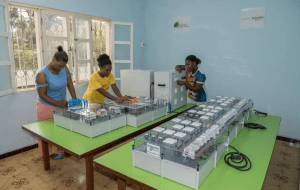This audio was created using Microsoft Azure Speech Services
As a consultant engineer, you may have heard about the energy transition and the emergence of a new energy landscape. This shift towards more sustainable energy sources and decentralized electrical systems is not only a trend but a necessary step towards a greener future. However, with this change comes the need for standards to ensure the compatibility, resilience, and safety of these new energy systems. In this blog post, we will explore the importance of standards in navigating the new energy landscape and how they can help your business stand out from competitors while complying with emerging regulations.
Standardization key for robust energy transition
The transition to a new energy landscape is heavily reliant on standardization. Standards act as a universal language that ensures all components within the energy system are compatible, operate efficiently, and are safe for use. For instance, AC and DC microgrids, which form a significant part of decentralized energy systems, require robust standards to manage their design and enable their integration within energy distribution. The establishment of such standards by IEC TC8B for decentralized electrical systems underscores the importance of creating a reliable framework that all stakeholders can adhere to.
Likewise, the specification of AC/DC power conversion standards by TC22/SC 22E is crucial in facilitating the seamless integration of renewable energy sources into the grid, ensuring that energy conversion processes are optimized for both performance and safety.
These examples illustrate how standardization serves as a cornerstone in the deployment of new energy technologies, paving the way for a smooth transition by providing a clear set of guidelines for design, implementation, and compliance, thereby supporting the global shift towards a more sustainable and efficient energy paradigm.
Standards for decentralized energy resources and microgrids
Decentralized electrical systems, such as microgrids and distributed energy resources, are at the forefront of the new energy landscape. These systems require specific standards to ensure they can be efficiently sized, tested, and validated, particularly through the use of models and digital twins (eg., IEC 62898 serie from TC8 SC8B). The International Electrotechnical Commission (IEC), through its Technical Committee (TC8A & TC8B), plays a crucial role in this aspect. The committee’s work, including standards like IEC 63406, is essential for the development and implementation of decentralized systems. By establishing a framework for the integration of renewable energy sources and the management of energy storage and distribution, these standards facilitate a more resilient and green energy system. The emphasis on standardization allows for the optimization of system design and operation, enabling stakeholders to predict performance and address potential issues before they arise. This proactive approach is vital in advancing the capabilities of decentralized electrical systems, ensuring they meet the demands of a rapidly evolving energy sector without compromising on reliability or safety.

Safety first
The advent of new energy landscapes brings forth the necessity for enhanced power conversion and electrical protection standards to safeguard both human lives and infrastructure. The development and implementation of such standards are spearheaded by specialized technical committees, notably TC22/SC 22E for direct current power conversion and TC95 for electrical protection mechanisms. Electrical protection must ensure short circuit interruption as well as discrimination with different configurations delivering different short circuit powers. This is managed within Technical Committee (TC95) at IEC level.
Moreover, new DC grids require specific protection. This is defined within TC 121/SC 121A (eg., IEC 60947-10).
The integration of renewable energy into existing grids and the emergence of new DC grids demand rigorous safety standards, as outlined by TC64 (e.g., IEC 60364). This standard serves as the bedrock for electrical installations, offering a framework that ensures the safety of installations within both local energy systems and broader DC grids. It mandates the adoption of practices that protect against electrical shocks, fires, and other risks, thus maintaining the integrity of power systems and ensuring the safety of people and goods.
Compliance with grid codes and dynamic modeling
The integration of decentralized energy resources into the broader electrical grid necessitates adherence to grid codes, as defined by TC8 SC8A, like within the 62786 series. These standards ensure that the connection and operation of decentralized systems do not compromise the stability and reliability of the electrical grid. Compliance with these grid codes is critical for maintaining system integrity, especially as the penetration of renewable energy sources increases. Dynamic modeling, as advocated by TC8A, plays a pivotal role in this process by providing tools for the simulation and analysis of grid behaviors under various scenarios. This capability is essential for predicting the impact of decentralized energy resources on grid performance and for developing strategies to mitigate potential issues.
In conclusion, the adoption of comprehensive standards is fundamental to the deployment of new energy solutions within the evolving landscape. By providing a framework for efficiency, safety, and reliability, these standards support the robust integration of decentralized energy resources, facilitating a smooth energy transition without compromising safety. Through standardization, the new energy landscape can achieve the resilience and sustainability needed to meet current and future challenges.




Add a comment